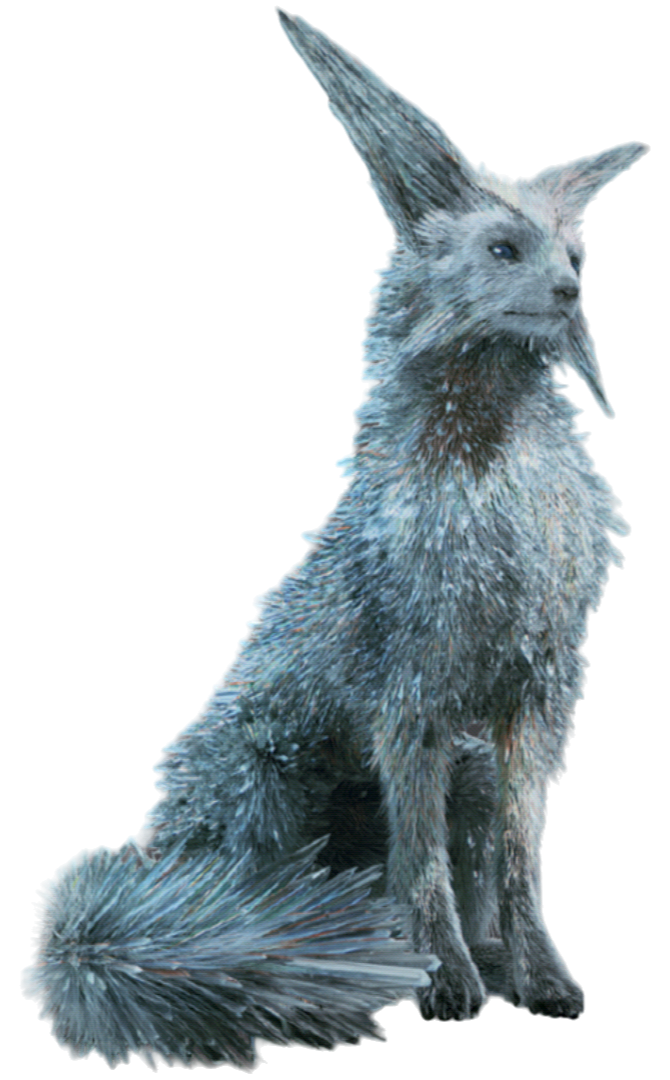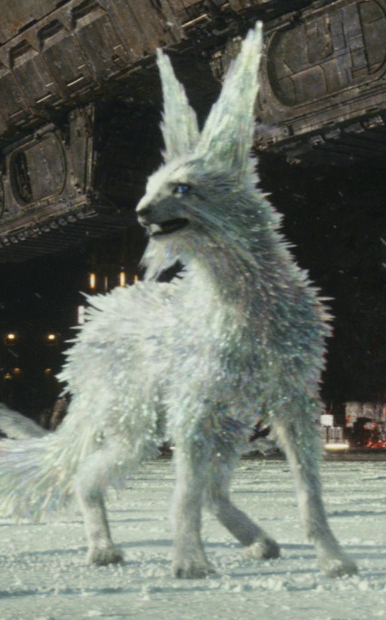
Vulptices were a species of fox with crystaline coat.
The vulptices were a fox-like species of canids with a flexible body native to the mineral world Crait. Their most distinctive feature was a coat of crystaline bristles/spines that served as protection against their predators. The jingling sounds resulting from this coat helped warn other vulptices about danger. Their facial bristles (or whiskers) also helped them gauge whether they could fit into a tight space. Vulptices had excellent low-light vision and keen senses. They were omnivorous, feeding on tubers and small burrowing mammals they dug out from under Crait's salt crust. According to Doctor Paqin Mesoli, who wrote field notes on the vulptices for the Nupayuni Mining Consortium, those creatures might also have been sensitive to magnetic fields.

The empathetic vulptex on Crait
Vulptices were most active at dawn and dusk. They congregated in cave dens at night. Vulptices dwelled in highland caves and canyons. Dr. Mesoli theorized that they had summer dens beneath Crait's salt crust, and winter dens in caverns. They lived in groups referred to as skulks, regrouping three to four families with as many as ten creatures by family. Dr. Mesoli, however, observed those skulks came together in larger social structures, with as many as one hundred vulptices sharing a particularly advantageous den.
Although not sentient, the vulptices were clever animals that formed strong bonds and hunted in cooperation. Dr. Mesoli suspected that they used their bristles to communicate, shaking them or brushing them against stones to generate specific sound patterns. They also appeared to be empathetic, even to members of other species, demonstrated by the individual that led trapped members of the Resistance out of their base on Crait.

A vulptex on the salt-covered surface of Crait
During the High Republic Era they could be found on the Outer Rim planet Valo. While in Valo's Lonisa City Zoo in 229 BBY, the Jedi youngling Gavi walked through an abandoned exhibit in the zoo, hearing the fur of a family of vulptices tinkling against nearby underbrush.
After the Rebel Alliance abandoned their outpost on the planet, a skulk of vulptices came to roam free through the abandoned structures. In 34 ABY, an extremely curious skulk of vulptices was present near the base during the time of a battle that broke out between the First Order and the Resistance on Crait's surface, but retreated into the outpost, remaining inside for the duration of the battle. When the battle stalled thanks to a distraction by Jedi Master Luke Skywalker, the vulptices located and exploited an unrecorded exit to the base. However, one vulptex stayed behind and led the surviving Resistance members to the escape route used by the skulk, a narrow crevice within a mound of boulders that was unfortunately too small to be used by the desperate rebels. Luckily, the Jedi-in-training Rey noticed the vulptices leaving the outpost through the blocked exit, and used the Force to move the rocks out of the way, allowing the Resistance members to escape.
Vulptices were designed for Star Wars: Episode VIII The Last Jedi, the eighth film in the Star Wars saga, which was released on December 15, 2017. They were first revealed in The Last Jedi behind-the-scenes footage from the D23 Expo released on July 15, 2017, displaying the animatronics that were used to bring the creatures to life. The vulptices made their first appearance in the Crait sequence of Star Tours: The Adventures Continue, Disney's simulator ride theme park attraction, which debuted at Disneyland Park and Disney's Hollywood Studios on November 17, 2017.
According to Neal Scanlan, the creature effects supervisor for The Last Jedi, feeding off Crait for a long time was the reason for these foxes' crystalline fur. In this way, "they've taken on the very surface of the planet they live on." The designers took inspiration from "crystal glass chandeliers and the sort of luminosity and elements of refraction" they create.
Although the filmmakers originally experimented with creating the creatures in part as a practical effect using live animals, the final version was entirely CGI, as it was felt that the version with live animals did not match the beauty of the original design, which had been created by creature concept designer Tim Napper, then developed by ILM.
Lucasfilm Story Group's Pablo Hidalgo came up with their name from the Latin word for fox, and the name of the fox genus, vulpes and vertices (singular: vertex), or the corners of any polyhedron, a shape associated with crystals.
When asked by Brian Lynch what the vulptices eat, The Last Jedi director Rian Johnson responded that they eat a combination of Craithian shrub grass and mole mice, whenever they can find them.
- Star Tours: The Adventures Continue
- LEGO Star Wars: The Skywalker Saga